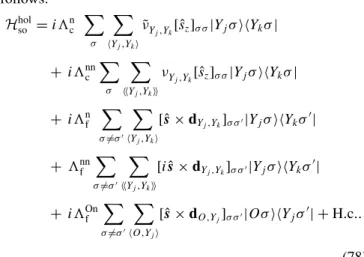Model spin-orbit coupling Hamiltonians for graphene systems
Denis Kochan,*Susanne Irmer, and Jaroslav Fabian
Institute for Theoretical Physics, University of Regensburg, 93040 Regensburg, Germany (Received 27 October 2016; published 12 April 2017)
We present a detailed theoretical study of effective spin-orbit coupling (SOC) Hamiltonians for graphene-based systems, covering global effects such as proximity to substrates and local SOC effects resulting, for example, from dilute adsorbate functionalization. Our approach combines group theory and tight-binding descriptions. We consider structures with global point group symmetriesD6h,D3d,D3h,C6v, andC3vthat represent, for example, pristine graphene, graphene miniripple, planar boron nitride, graphene on a substrate, and free standing graphone, respectively. The presence of certain spin-orbit coupling parameters is correlated with the absence of the specific point group symmetries. Especially in the case ofC6v—graphene on a substrate, or transverse electric field—we point out the presence of a third SOC parameter, besides the conventional intrinsic and Rashba contributions, thus far neglected in literature. For all global structures we provide effective SOC Hamiltonians both in the local atomic and Bloch forms. Dilute adsorbate coverage results in the local point group symmetriesC6v,C3v, andC2v, which represent the stable adsorption at hollow, top and bridge positions, respectively. For each configuration we provide effective SOC Hamiltonians in the atomic orbital basis that respect local symmetries. In addition to giving specific analytic expressions for model SOC Hamiltonians, we also present general (no-go) arguments about the absence of certain SOC terms.
DOI:10.1103/PhysRevB.95.165415 I. INTRODUCTION
The ability to synthesize, manipulate, and functional- ize 2D materials is an ultimate milestone in technological development and current fundamental research, including spintronics [1,2]. One of the major challenges is controlling, engineering, and harvesting spin degrees of freedom for faster data processing, storage, etc. Graphene seems to be a promising material [3] for such applications due to its high bipolar mobility [4], chemical and mechanical [5] stability,
“relativistic” band structure [6] with chiral electrons that are highly insensitive to backscattering [7,8], and, importantly for spintronics, weak intrinsic spin-orbit coupling (SOC) [9]. The latter was theoretically estimated [10–14] to yield long spin lifetimes—orders of microseconds—enough for harvesting electron spins as “carriers of information.” However, exper- iments carried out on graphene devices of the first generation gave spin lifetimes three order of magnitudes smaller [15–21].
This vast discrepancy can be reliably explained assuming a small amount (orders of ppm) of resonant magnetic scatters [22–24] like for example hydrogen atoms [25,26] or vacancies [26,27]. Related theoretical studies [28–30] confirmed that magnetic moments, indeed, strongly affect spin dynamics and can cause the ultra-fast spin relaxation. A recent experiment of the Valenzuela group [31], analyzing graphene’s spin-lifetime anisotropy, supports that view and convincingly rules out SOC as a determining factor of the fast spin relaxation.
On the other hand, enhancing SOC in graphene is desirable as well. Indeed, graphene with strong intrinsic SOC is predicted to host the quantum spin Hall phase [32]. Therefore, one of the current technological and theoretical challenges is to tailor the strength of SOC of graphene in a controllable manner.
In fact, SOC can be significantly enhanced either by chemical functionalization—coating of graphene with light [33–39] or heavy [40–43] adatoms—accompanied by band gap opening,
*denis.kochan@physik.uni-regensburg.de
curvature as in the case of carbon nanotubes [44,45], or by a variety of proximity effects resulting from substrates or due to scaffolding of different 2D materials [46]. Tangible examples are CVD graphene grown on Cu and Ni substrates [47–49], or graphene placed on top of transition metal dichalcogenides [50–53].
To further examine SOC effects in functionalized graphene and also design device properties, one needs an effective model that allows reliable simulations of the spin and charge transport characteristics [28,54–68]. In this paper, we present a detailed symmetry analysis focusing on effective SOC Hamiltonians in a way that is complementary to Refs. [40,58,69]. Our findings remain valid for any hexagonal (graphenelike) structure pos- sessingπorbitals and are easily transferable to other systems.
The primary aim of this manuscript is to lift the curtain and show practically how to derive the corresponding SOC Hamil- tonians from the given pools of global or local symmetries.
We discuss two cases: global SOC Hamiltonians that represent proximity induced phenomena or periodically func- tionalized structures, and local SOC Hamiltonians that govern spin dynamics in the vicinity of adsorbates. Starting with pristine graphene, we step-by-step reduce the number of global symmetries approaching structures such as graphene miniripple, staggered graphene, planar boron nitride, silicene, graphene on a substrate, graphone, etc. For each representative case, which is classified by the associated subgroup of the full hexagonal group, we derive an effective SOC Hamiltonian in real and reciprocal spaces, respectively. Our analysis therefore covers also quasimomenta that are not necessarily constrained to the vicinity of Dirac points.
In the case of local impurities, we focus on the reduction of local symmetries up to a certain spatial extent from the adsorbate. The three representative adsorption positions are hollow, top, and bridge and we provide here the local SOC Hamiltonians in real space. Group arguments allow us to link the presence or absence of certain symmetries to various spin- orbit couplings that emerge in the effective SOC Hamiltonian.
For example, in the global case corresponding to point group
C6v—graphene in a transverse electric field or deposited on a substrate—we highlight the presence of a SOC term that have not yet been considered. It appears along with the conventional intrinsic and Rashba couplings and is related to the absence of the principal mirror plane in the structure.
The paper is organized as follows. After recapitulating the basic group theory related with the full hexagonal system and its application to SOC matrix elements in Sec.II, we discuss separately translational invariant systems, Sec.III, and systems lacking that invariance (local adsorbates), Sec.IV. In sections of III, we cover in detail SOC in pristine graphene, point groupD6h, and effective SOC Hamiltonians in systems that are characterized by one of its subgroups: D3d, D3h, C6v, and C3v. Section IVis devoted to local SOC Hamiltonians for the three stable adsorption positions—hollow, top, and bridge, respectively. Summary and final remarks are provided in Sec.V.
II. GROUP THEORY AND SOC: PRELIMINARIES A convenient approach how the group theory enters effective model building is a decomposition of the Hamiltonian matrix elements associated with the problem into irreducible representations (irreps). Those are well known and standardly tabulated for all crystallographic point groups [70,71]. Consid- ering spin and spin-orbit interaction the irrep analysis around the high-symmetry points in the Brillouin zone becomes more involved. This is because the associated double (also called spinor) group representations should be appropriately taken into account; the case of graphite is exhaustively discussed in the thesis of Slonczewski [72]. For a general overview and connection with the theory of group invariants, see the book of Bir and Pikus [73], or Winkler [74].
Another possibility how to derive an effective SOC Hamil- tonian is to employ the multi-orbital tight-binding approach [75–78]. The group symmetry analysis on the orbital level is straightforward and well described by the Koster-Slater two-center approximation [79] and, consequently, SOC enters as the intra-atomic LS interactionξLˆ·S. The resulting multi-ˆ orbital tight-binding Hamiltonian is then downfolded by means of the L¨owdin projection [80] to the states of interest—mostly the low-energy states with respect to the Fermi level.
As an alternative to the invariant expansion and the multi- orbital tight-binding method with the L¨owdin projection, we present here an effective tight-binding approach that employs symmetries of local atomic orbitals. We focus particularly on hexagonal lattice structures assuming the low-energy physics near the Fermi level can be approximately well described by π orbitals, i.e., carbon 2pzorbitals, or atomic orbitalsn,= 0,m=0. For simplicity, we consider that each nodal atomic site mcontains one effective π-orbital state,|Xm ≡c†m|0. When it is necessary to specify the sublatticeX, we explicitly write|Amand|Bmfor the two atomic sites in a hexagonal lattice. Including also electron spin,σ = {↑,↓} ≡ {+1,−1}, the effective one-particle Hilbert space is spanned by states
|Xmσ ≡c†m,σ|0.
The structural point group of an ideal hexagonal lattice is the symmetry groupD6h—in international crystallographic notation group 6/mmm. It contains 24 group elements which can be expressed in terms of four group generators: identity
C3,6zˆ ;S3,6ˆz C2zˆ;I Σyzv
C2ˆy Σxzd Σ˜d
C2ˆx
Σxyh (a)
x
y z
A3
B2
B1
A1
A2
B3
(b)
1
A3 2
B2 3
(c)
FIG. 1. Panel (a) shows selected symmetry operations of point groupD6h. Combining the point group generators (blue symbols)—
horizontalxyh , verticalvyz, and dihedral ˜d reflections, one can built all the remaining group elements (black symbols). Lower panels depict (b) sites’ labeling convention and axes orientation, and (c) graphene unit cell together with the Bravais lattice vectorsRα(α= 1,2,3).
Eand reflectionsh≡hxy,v ≡vyz,˜d, for visualization see Fig. 1. Subscripts h, v, and d stand for the horizontal (xyplane), vertical (yzplane), and dihedral (rotatedxzplane) reflections, respectively. When it is convenient to emphasize the reflection planes explicitly, we employ the superscriptsxz, yz, andxy. Similarly, to specify the axis determining a spatial rotation we use hat superscripts, such as ˆx, ˆy, and ˆz. The remaining elements ofD6hare sixfold and threefold rotations, C6zˆ=˜d◦v andC3zˆ =C6ˆz◦C6ˆz, thexz-dihedral reflection d ≡dxz=C3zˆ◦˜d, the space inversionI =h◦d◦v, the improper rotationsS6zˆ =h◦C6zˆ,S3zˆ=h◦C3ˆz, and the twofold rotations C2xˆ =h◦d, C2yˆ =h◦v, and C2zˆ = v◦d, see Fig.1.
To construct an invariant SOC Hamiltonian, it is necessary to know how the one-particle basis states|Xmσ transform under the active action of D6h including the time reversal symmetryT. While we are not dealing with the double group irreps it is enough to focus on the action of selected group elements: rotationRˆzby an angle, the horizontal, vertical, and dihedral reflectionsh,v, andd, respectively, the time reversalT, and for completeness also the space inversion I and the translationTaby a lattice vectora:
|Xmσ −→R e−iσ2XR(m)σ
, (1a)
|Xmσ
xy
−−→h i(−1)1+σ2 |Xmσ, (1b)
|Xmσ −−→vyz iXvyz(m)(−σ)
, (1c)
|Xmσ −−→dxz (−1)1+σ2 Xxzd(m)(−σ)
, (1d)
|Xmσ −→T (−1)1−σ2 |Xm(−σ), (1e)
|Xmσ −→ −|I XI(m)σ, (1f)
|Xmσ −→ |Ta Xm+aσ. (1g) The action of the remainingD6helements follow immediately from the relations to the group generators. The action of T affects only the spin component of|Xmσ = |Xm ⊗ |σsince, by convention, our orbitalπstates|Xmare real-valued wave functions.
An electron moving in an effective crystal field potential V is affected by SOC interaction that is represented by Hamiltonian,
Hˆso= h¯
4m2ec2(∇V ×p)ˆ ·ˆs. (2) Here, me is the vacuum rest mass of the electron, c is the speed of light, ˆp stands for the momentum operator, and ˆ
s=(ˆsx,ˆsy,ˆsz) represents the array of Pauli matrices acting on spin degrees of freedom. In reality, we do not know the crystal field and so ˆHso exactly, but knowing the pool of symmetries preserving V, and hence ˆHso, we can uniquely detect which matrix elements Xmσ|Hˆso|Xnσ are nonzero and thus important. IfS is a system’s symmetry—precisely, itsunitaryrepresentation—thenSHˆso=HˆsoSand
S[Xmσ]|Hˆso|S[Xnσ] = S[Xmσ]|S[ ˆHsoXnσ]
= Xmσ|Hˆso|Xnσ (3) for any two one-particle states |Xmσ and |Xnσ. In an analogous way, we get for the antiunitary time reversal symmetry,THˆso=HˆsoT, and self-adjoint ˆHso
T[Xmσ]|Hˆso|T[Xnσ] = T[Xmσ]|T[ ˆHsoXnσ]
= Xmσ|Hˆso|Xnσ
= Xnσ|Hˆso|Xmσ. (4) This gives us a practical relation connecting SOC matrix elements with opposite spin projections:
Xmσ|Hˆso|Xnσ
(1e)= (−1)−1−σ2 T[Xm(−σ)]|Hˆso|(−1)−1−σ2T[Xn(−σ)]
= −(−1)σ+σ2T[Xm(−σ)]|Hˆso|T[Xn(−σ)]
(4)= −(−1)σ+2σXn(−σ)|Hˆso|Xm(−σ). (5) In practice, we focus only on the on-site, nearest neigh- bors, and the next-nearest-neighbor SOC mediated hoppings Xmσ|Hˆso|Xnσ. This is sufficient because the orbital over- laps modulated by ∇V—dominant near the atomic cores—
decay rather fast with increasing distance. Therefore we focus on SOC hoppingsXmσ|Hˆso|Xnσinside one particular elementary cell of the hexagonal lattice, see Fig.1. All other spin-resolved hoppings can be expressed by applying transla- tions, rotations, reflections, or time reversal, see Eqs. (1).
In what follows we show how time reversal symmetry and self-adjointness of ˆHso restrictXmσ|Hˆso|Xnσ. Particulary, we argue that the spin-conserving hoppingsXmσ|Hˆso|Xnσ are purely imaginary, and the on-site SOC resolved hoppings
Xmσ|Hˆso|XmσandXmσ|Hˆso|Xm(−σ)vanish. First, note that the SOC Hamiltonian ˆHso, Eq. (2), can be recast into the form
Hˆso=Lˆ+sˆ−+Lˆ−sˆ++Lˆzsˆz, (6) where ˆs±=12(ˆsx±isˆy) are spin raising and lowering oper- ators (without h¯2) and ˆL’s act solely on the orbital part of the wave function. It follows from the hermiticity of ˆHso that ˆL†−=Lˆ+ and ˆLz is self-adjoint. Also L’s transform under the space and time reversal symmetries equally as the standard angular momentum operators. However, for a general crystal field potentialV they do not obey the usual SU(2)-commutation relations. Directly from Eq. (6) we have
Xmσ|Hˆso|Xnσ = −Xm(−σ)|Hˆso|Xn(−σ). (7) On the other side, the time reversal symmetry, Eq. (5), implies
Xm(−σ)|Hˆso|Xn(−σ)(5)= Xnσ|Hˆso|Xmσ
= Xmσ|Hˆso|Xnσ. (8) So comparing this and the above expression, we see that
Xmσ|Hˆso|Xnσ (9) is a purely imaginary SOC matrix element for any two atomic sites mediating a spin-conserving hopping. In the special case m=n, the above Eqs. (5) and (7) give
Xmσ|Hˆso|Xmσ(5)= Xm(−σ)|Hˆso|Xm(−σ)
(7)= −Xmσ|Hˆso|Xmσ, (10) so that we have shown thatthe on-site spin-conserving term Xmσ|Hˆso|Xmσequals zero for any sitem. In a similar way we get for its spin-flipping counterpart:
Xmσ|Hˆso|Xm(−σ)(5)= −Xmσ|Hˆso|Xm(−σ), (11) so the on-site spin-flipping matrix element Xmσ|Hˆso| Xm(−σ)is zero for any lattice sitem. Therefore what matters are the nearest- and next-nearest-neighbor SOC mediated matrix elements, which we will examine in the forthcoming sections.
III. TRANSLATIONAL INVARIANT SYSTEMS A. Pristine graphene SOC Hamiltonian
The spin-orbit coupling Hamiltonian based onπstates that is translational invariant and possesses the full point group symmetryD6hof the pristine graphene allows only one, the so called intrinsic, SOC hoppingλI. This was first discussed by McClure and Yafet [81] when analyzing thegfactor in a
“graphite single crystal.” Later Kane and Mele [32] revisited this point when predicting the quantum spin Hall effect in graphene. The magnitude of λI was found in the work of Gmitra et al. [9], who showed that λI is too weak—about 12 μeV—to induce an experimentally detectable transition into the quantum spin Hall phase. Furthermore, Gmitraet al.
[9] found thatλIis due to the coupling ofpzandd orbitals.
This was supported by multiorbital tight-binding calculations;
Konschuhet al.[75] showed that the intrinsic SOC hopping
λI is significantly affected by the admixture of 3dxz±i3dyz
orbitals, the fact anticipated already by Slonczewski [72].
The effective tight-binding Hamiltonian mediating the SOC interaction amongπ states in graphene—or any planar hexagonal system with oneπ-orbital per site—reads
HD6h = iλI 3√ 3
σ
m,n
νm,n[ˆsz]σ σ|XmσXnσ|. (12) The HamiltonianHD6h couples next-nearest neighbors (sum- mation over m,n) and allows only spin-conserving hop- pings. Therefore, in accordance with Eq. (9), the underlying coupling constant is purely imaginary. Using the configuration shown at Fig.1, the couplingiλIcan be defined as
iλI 3√
3 = A3↑|Hˆso|A2↑(7)= −A3↓|Hˆso|A2↓. (13a) The numerical factor 1/3√
3 is a matter of convention; adding it here, the low-energy expansion of the Bloch transform of HD6h becomes simpler. In the above formula and also below, we identify a lattice site mwith aπ state |Xm residing on it. Since each site hosts oneπ-orbital state, this assignment is unique. Moreover, since|A2↑ =xzd |B3↓, and|A3↑ = dxz|B2↓, see Fig.1, we can write
iλI 3√
3 = A3↑|Hˆso|A2↑(1d)=
dxz[B2↓]Hˆsodxz[B3↓]
(3)= B2↓|Hˆso|B3↓(7)= −B2↑|Hˆso|B3↑. (13b) All the sublattice and spin related sign factors are captured in the prefactor termνm,n[ˆsz]σ σ, i.e.,
Xmσ|Hˆso|Xnσ =νm,n[ˆsz]σ σ
iλI 3√
3. (14)
There,νm,n= +1(−1), if the next-nearest-neighbor hopping n→m via a common neighbor on the opposite sublattice is counter clockwise (clockwise), e.g., forA2→(B1)→A3, νA3A2= +1, while for B3→(A1)→B2, νB2B3 = −1, see Fig.1. The dependence on spinσ is governed by [ˆsz]σ σ; as defined [ˆsz]±±= ±1.
To see the effect of the intrinsic SOC on the band structure we transformHD6h, Eq. (12), from the local atomic into the Bloch basis,|Xmσ → |Xqσ:
|Xqσ = 1
√N1N2
Rm
eiq·Rm|Xmσ. (15) Here, X= {A,B} and σ = {↑,↓}, dependent on the sub- lattice and spin degrees of freedom, respectively, q is the quasimomentum measured from the center of the hexagonal Brillouin zone (point),N1N2is the number of graphene unit cells in the sample, and Rm is the lattice vector of themth cell that hosts the orbital|Xmσ. Inserting the above unitary transformation into Eq. (12), we transformHD6h to the Bloch form,HD6h =
qHD6h(q), where HD6h(q)=λIfI(q)
X,σ
[ ˆσz]XX[ˆsz]σ σ|XqσXqσ|. (16) Here, the Pauli matrix ˆσz acts in the space of sublattices—
[ ˆσz]AA=1= −[ ˆσz]BB, and [ ˆσz]AB=0=[ ˆσz]BA. The intrinsic
structural functionfI(q) reads, fI(q)= − 2
3√
3(sinq·R1+sinq·R2+sinq·R3). (17) The lattice vectorsRα(α=1,2,3) can be compactly expressed in terms of the Levi-Civita antisymmetric symbol and the position vectors of the lattice sitesA1,A2, andA3as displayed at Fig.1. Particularly,
Rα= 1
2αβγ−−−→
AγAβ =aL
cos2π(α−1)
3 ,sin2π(α−1) 3
, (18) whereaLis the lattice constant; in the case of grapheneaL = 2.46 ˚A.
On the orbital level the electronic band structure of grapheneπorbitals is well described by the standard nearest- neighbor Hamiltonian,
Horb= −t
σ
m,n
|XmσXnσ|, (19) witht=2.6 eV. Transforming it to the Bloch form, we arrive atHorb=
qHorb(q), where Horb(q)= −t
σ
forb(q)[ˆs0]σ σ|AqσBqσ| +H.c., (20) and the orbital structural function is given by
forb(q)=(1+eiq·R2+e−iq·R3); (21) ˆ
s0is the identity matrix in spin space.
In what follows, we focus on the low-energy physics near the Dirac points,
±K= ±4π
3aL(1,0), (22)
i.e., we substitute forq= ±K+k and expand the relevant q-dependent quantities in k keeping the first nonzero term.
For the above defined structural functions, we particularly get fI(±K+k) ±1 (23) and
forb(±K+k)
√3aL
2 (∓kx−iky). (24) Fixing the order {|Aq↑, |Aq↓,|Bq↑,|Bq↓} of the Bloch basis, we arrive at the effective low-energy Hamiltonian in the form
Heff(τK+k)=hv¯ F(τ kxσˆx−kyσˆy)ˆs0+τ λIσˆzsˆz. (25) Here,τK= ±Kis the shorthand for the Dirac valleys, ˆσx(y) are Pauli matrices in the sublattice space, andvF =√
3aLt /2¯h stands for the Fermi velocity; for example, for graphenevF ≈ 106m/s.
From the above Bloch representation, we see that ˆσ0sˆz commutes with Heff, and hence its eigenstates can be la- beled by the spin ↑ and ↓ projections along the z spin quantization axis independently of k. The eigenspectrum of Heff, dependent on the quasimomentum k, band index n= +/− = conduction/valence, and spinσ = {↑,↓}, reads
εn,σ(τK+k)=n λ2I +h¯2v2F
kx2+ky2
. (26)
-10 -5 0 5 10
|k| [10-6 Å]
-50 -25 0 25 50
E [µeV]
FIG. 2. Electronic band structure of the typical graphenelike system in the vicinity of the Dirac point (|k| =0) with (solid line) and without (dashed line) the intrinsic (D6hinvariant) SOC Hamiltonian.
The spectral gap of 2λI and the parabolic shape near|k| =0 are typical imprints of the intrinsic SOC which does not spin-split the bands.
The corresponding four eigenstates get grouped into pairs, each pair comprising states with the opposite spins, e.g., directly at theτKpoints, we have two pairs{|AτK↑,|BτK↓}
and{|AτK↓,|BτK↑}, that are split in energy by the intrinsic SOC; spin-orbit interaction opens a spectral gap at the Dirac points. In the case of graphene, the intrinsic gap equals [9]
2λI24μeV. The spectral effects of the intrinsic SOC that are imprinted on the band structure are shown at Fig.2.
B. No-go SOC matrix elements—lethal symmetries In what follows, we shortly summarize no-go arguments showing explicitly how certain SOC mediated matrix elements become inhibited by specific structural symmetries. This will on one hand prove why for pristine graphene only the spin-conserving next-nearest-neighbor couplingλIis allowed.
On the other hand, by seeing the absence of a particularno-go symmetry in the symmetry group of a reduced hexagonal structure we can infer which additional coupling is allowed in the corresponding effective SOC Hamiltonian. We will profit from this insight in the forthcoming sections.
1. Inhibition of all spin-flip SOCs—horizontal reflection Applying horizontal reflection hxy to a general spin-flip matrix element Xmσ|Hˆso|Xn(−σ) between two π states localized on arbitrary lattice sites m and n, we get in accordance with Eq. (1b),
Xmσ|Hˆso|Xn(−σ)
= i(−1)1−σ2 hxy[Xmσ]|Hˆsoi(−1)1+σ2 hxy[Xn(−σ)]
= −
hxy[Xmσ]Hˆsohxy[Xn(−σ)]
(3)= −Xmσ|Hˆso|Xn(−σ), (27)
what implies thatXmσ|Hˆso|Xn(−σ) =0. Hence we showed that the presence ofhxy in the reduced point group inhibits any spin-flip terms in the effective SOC Hamiltonian. Ifhxy
would not be present, then we would have a weaker result as discussed below.
2. Inhibition of the nearest-neighbor spin-flip SOCs—space inversion, lattice translation, and time reversal
For concreteness, let us focus on the SOC matrix element A2σ|Hˆso|B3(−σ); see Fig. 1. Employing consecutively space inversionI, Eq. (1f), unitarity, Eq. (3), and translation by the lattice vectora=−−−→
A3A2=−−→
B2B3, Eq. (1g), we get A2σ|Hˆso|B3(−σ) = −I[B2σ]|Hˆso| −I[A3(−σ)]
= I[B2σ]|Hˆso|I[A3(−σ)]
(3)= B2σ|Hˆso|A3(−σ)
= Ta[B3σ]|Hˆso|Ta[A2(−σ)]
(3)= B3σ|Hˆso|A2(−σ). (28a) To proceed further, we use the time reversal symmetry, Eq. (5), B3σ|Hˆso|A2(−σ)(5)= −A2σ|Hˆso|B3(−σ). (28b) Combining Eqs. (28a) and (28b), we immediately see that the nearest-neighbor SOC mediated spin-flip hopping A2σ|Hˆso|B3(−σ) =0. Repeating the same for the remaining neighboring lattice sites at Fig. 1 we inhibit—by the space inversion I, lattice translationTa and time reversal T—all other nearest-neighbor spin-flip terms in the effective SOC Hamiltonian.
3. Inhibition of the nearest-neighbor spin-conserving SOCs—vertical reflection and lattice translation
By similar reasoning as above, we can show that the SOC matrix elementA2σ|Hˆso|B3σis zero whenever lattice trans- lationTa and vertical reflectionvyzare present. Translation by the lattice vectora=−−−→
A2A3=−−→
B3B2implies A2σ|Hˆso|B3σ = Ta[A3σ]|Hˆso|Ta[B2σ]
(3)= A3σ|Hˆso|B2σ. (29a) Moreover, using the vertical reflection, Eq. (1c), we have
|A3σ = −iyzv |A2(−σ) and|B2σ = −ivyz|B3(−σ) and therefore, by unitarity, Eq. (3), we arrive at
A3σ|Hˆso|B2σ = A2(−σ)|Hˆso|B3(−σ). (29b) So the last two equations together with Eq. (7) imply
A2σ|Hˆso|B3σ = A2(−σ)|Hˆso|B3(−σ)
(7)= −A2σ|Hˆso|B3σ, (29c) which means that the nearest-neighbor spin-conserving hop- pingA2σ|Hˆso|B3σis zero. Repeating the same argumenta- tion for the other neighboring sites we eliminate—by lattice translation Ta and vertical reflection yzv —all remaining nearest-neighbor spin-conserving SOC terms.
The no-go arguments based on the horizontal and verti- cal reflections hxy,yzv ∈D6h, see Eqs. (27) and (29), ex- plain straightforwardly why the translationally invariant SOC HamiltonianHD6h of pristine graphene, Eq. (12), allows only
C3,6zˆ ; S3,6zˆ C2zˆ; I Σyzv
C2ˆy Σxzd
C2xˆ
Σxyh
D
6h{λ
I}
C3,6zˆ C2zˆ Σyzv
Σxzd E
C
6v{λ
I, λ
PIA, λ
R}
C3zˆ; S3ˆz Σyzv
C2ˆy Σxyh
D
3h{λ
AI, λ
BI}
C3zˆ; S6ˆz I C2xˆ
Σyzv
D
3d{λ
I, λ
PIA}
C3zˆ Σyzv
E
C
3v Σyzv C3zˆ Σyzv C3zˆ E{λ
AI, λ
BI, λ
APIA, λ
BPIA, λ
R}
FIG. 3. Point group D6h of pristine graphene (top), its maximal subgroups D3d, D3h, and C6v (second row), and the corresponding symmetry operations (blue symbols). SubgroupsD3d,D3h, andC6vare represented, for instance, by graphene mini-ripple, planar boron-nitride and graphene exposed to a transverse external electric field, respectively. They share the common subgroupC3v (third row) what is, for example, the symmetry group (left to right) of graphene mini-ripple in a transverse external electric field, mini-rippled boron-nitride, and boron-nitride in a transverse external electric field. The successive reduction of the point group symmetry (top to bottom) enhances the number of symmetry-allowed SOC parameters, those are summarized in brackets.
the next-nearest-neighbor spin-conserving hoppings. Pristine graphene is an example of a hexagonal system with the highest structural group symmetry. The topic for the next sections are hexagonal systems with lower symmetries—subgroups of the point group D6h. We will start with the maximal structural subgroups D3d,D3h, andC6v—and explore step-by-step the symmetry allowed spin-orbit couplings.
C. Subgroups ofD6h—categorization of emergent SOCs Any periodic modification of the pristine hexagonal sym- metry reduces the unit cell point group symmetryD6hto one of its subgroups and is manifested by the emergence of new SOC mediated hoppings. The aim of this section is to show a bottom line enabling their classification and categorization.
The minimal structural modifications we will discuss here are (1)rippling, (2)sublattice asymmetry, and (3)transverse electric field or substrateand their mutual combinations, see Fig. 3. We call here a structural modification of the full hexagonal lattice minimal, if the reduced point subgroup of D6h experiences minimal modifications in terms of the
number of group elements. Such subgroups are usually called maximal subgroups. In the case of D6h, there are in total five maximal subgroups [70]. Each of them has 12 group elements—group order 12—which is half of the order of the original point group D6h. Three subgroups—D3d, D3h, andC6v—will be relevant in the present context, while the subgroups D6 andC6h are irrelevant for us. To be specific, (1) rippling reduces D6h→D3d what constitutes the point group of graphene miniripple, graphane [82], silicene, and
“germanene” [83,84], etc.; (2)sublattice inversion asymmetry reducesD6h→D3hwhat is the point group of the planar boron nitride, aluminum nitride, or any other planar system with two nonequivalent interpenetrating triangular latticesAandB; (3) transverse electric fieldreducesD6h→C6v what represents the point group of pristine graphene in an external field or graphene deposited on a substrate that is not breaking the sublattice symmetry. For visualization, summary, and mutual comparison see Fig.3and TableI.
It is worth to emphasize that an intersection of any two of D3d, D3h, and C6v is isomorphic [70] to the smaller non-Abelian subgroup C3v ⊂D6h with group order 6. This
TABLE I. Point groupD6hand its maximal subgroups—D3d,D3h,C6v—including also their common intersection—the point groupC3v. For the visualization see Fig.3. We shortened the notation in terms of the previous definitions: symbol 2C6ˆzmeans two sixfold rotations along thezaxis, namely,Rˆz±π/3, symbol 3C2 stands for three twofold rotations along the axisx,Rzπ/3ˆ x, andRz2π/3ˆ x, respectively, and similarly 3C2 stands for three twofold rotations along they,Rzπ/3ˆ y, andRz2π/3ˆ yaxis, respectively. By the same logic, 3vstands for three mirror reflections inyz,Rzπ/3ˆ yz, andRz2π/3ˆ yzplanes, respectively, and so on. If the given set of operations is present/absent in the particular subgroup ofD6h, we employ the marker/–.
Group/Operation E 2Cz6ˆ 2Cz3ˆ C2ˆz 3C2 3C2 I h 3v 3d 2S3zˆ 2S6zˆ
D6h
D3d – – – – – –
D3h – – – – – –
C6v – – – – – –
C3v – – – – – – – – –
means that an arbitrary combination of two minimal structural modifications leads to the same effective SOC Hamiltonian, which possesses global C3v invariance. For concreteness, graphene miniripple (or graphane, silicene, and germanene) in a transverse electric field—D3d∩C6v—is from the effective SOC point of view equivalent to a minirippled boron nitride without the field or free standing graphone [85]—D3d∩D3h. With respect to the structural minimality the point groups D3d,D3h, andC6vcan be considered as equivalent since they are all maximal subgroups ofD6h. Despite of that minimal subgroup similarity,D3d,D3h, andC6vare different since they result in different SOC phenomena.
1. D3dcase:λIandλPIAcouplings
Rippled structures such as graphane, silicene, and graphene miniripple—point group D3d—remain invariant under the space inversionIand time reversalT, and hence SOC can not cause band spin splittings. The reasoning is finger counting [2]; for any band indexn, we have
εn,σ(k)=T εn,−σ(−k)=I εn,−σ(k). (30) Space inversionI and vertical reflectionyzv belong toD3d, but the horizontal reflection hxy does not. Then, according to the no-go arguments presented in Sec. III B, the D3d symmetric and time reversal invariant SOC Hamiltonian based onπorbitals allows only next-nearest-neighbor hoppings. The nearest-neighbor SOCs are inhibited—the spin-conserving ones byvyzand spin-flipping byI. BecauseI interchanges sublattices, |Aiσ = −I|Biσ, see Fig. 1 and Eq. (1f), the next-nearest hoppings should not be sublattice resolved.
Indeed,
Aiσ|Hˆso|Ajσ(3)= Biσ|Hˆso|Bjσ. (31) Similarly,T interchanges the spin components,
Xmσ|Hˆso|Xnσ
(5)= −(−1)σ+σ2 Xn(−σ)|Hˆso|Xm(−σ), (32) and hence there is only one purely imaginary spin-conserving hopping, say, defined forσ=σ = ↑, and one spin-flipping hopping defined forσ= −σ = ↓, respectively.
It is now a convention—by analogy with the plain graphene—to call the spin-conserving next-nearest-neighbor SOC matrix element intrinsic. Hence also in theD3d case we
adopt the term intrinsic SOC. We define intrinsiciλI by the same prescription as already given by Eq. (13):
iλI 3√
3 = A3↑|Hˆso|A2↑ = B2↓|Hˆso|B3↓. (33) The related sublattice-spin sign factors are governed by the prefactorνm,n[ˆsz]σ σas discussed above.
There is no terminological consensus on how to call the spin-flipping next-nearest-neighbor SOC matrix element. Such a term already emerged in bilayer graphene [86], but that time its group symmetry origin was not discussed. Later, when studying SOC effects in semi-hydrogenated graphene (graphone) the acronym PIA—a shorthand for the “pseudospin inversion asymmetry” was proposed [34]. In that case, the pseudospin was explicitly broken by the hydrogenation of one sublattice resulting in the C3v invariant structure. Un- fortunately, the pseudospin asymmetry is not supported by the point group D3d which contains the space inversion I. So the former PIA acronym is not fully appropriate inD3d case.
Alternatively, authors of Ref. [77] used the term “intrinsic Rashba SOC.” This is also inappropriate, since normally the Rashba [87] SOC causes band splittings and this is also not the case inD3dinvariant systems.
The emergence of the spin-flipping next-nearest-neighbor SOC is related to the absence of the horizontal reflectionhxy in the underlying point group (see also other cases discussed below). Since the horizontal plane is a principal mirror plane of the structure we can call it “principal plane mirror asymmetry”
induced SOC, preserving the subscript PIA (by explicitly breaking with abbreviation rule). Thus the PIA spin-orbit couplingλPIAcan be defined as
2
3λPIA≡ A3↑|Hˆso|A2↓(5)= −A2↑|Hˆso|A3↓. (34) Again, the numerical prefactor 2/3 is a matter of convenience.
Employing the vertical reflectionyzv ∈D3dwe show thatλPIA is purely real
A3↑|Hˆso|A2↓(1c)=
−iyzv [A2↓]Hˆso−ivyz[A3↑]
(3)= A2↓|Hˆso|A3↑ = A3↑|Hˆso|A2↓. (35)

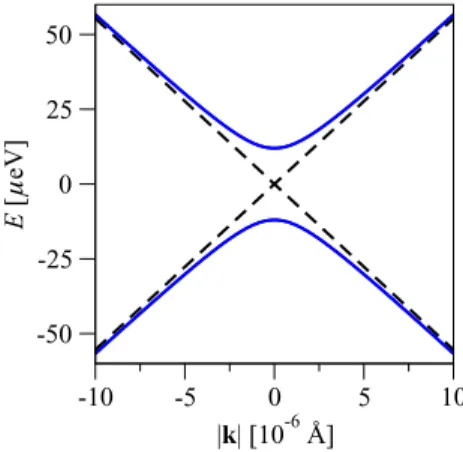
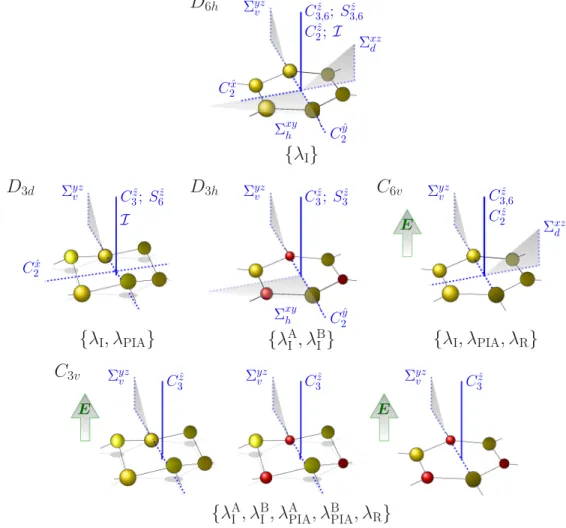

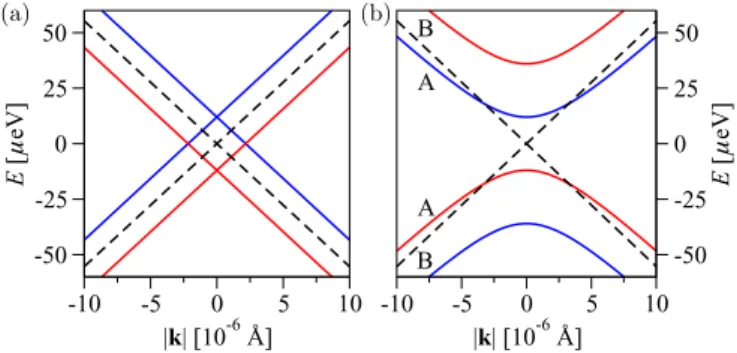
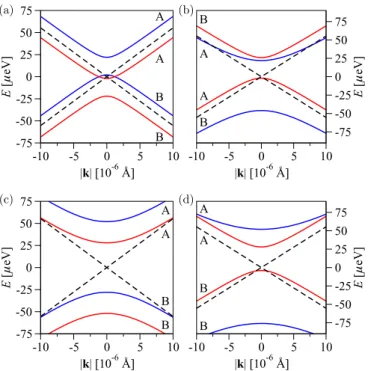


![TABLE II. Orbital tight-binding parameters for different adele- adele-ments: hydrogen, fluorine, methyl, and copper in top and bridge position [34–37].](https://thumb-eu.123doks.com/thumbv2/1library_info/3943545.1533802/13.911.470.838.156.281/table-orbital-binding-parameters-different-hydrogen-fluorine-position.webp)
